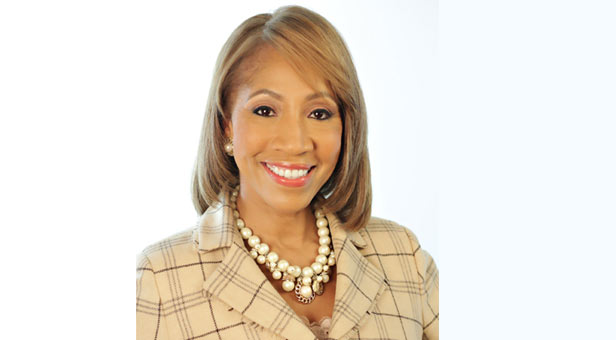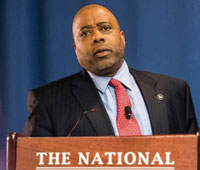

Black media slighted as spending power exceeds $1 trillion
Neilsen Senior Vice president Cheryl Pearson-McNeil says Black consumers should invest in companies that invest in them. (Photo by Ann Ragland)
By George E. Curry
WASHINGTON, D.C. (NNPA) – Although annual Black spending is projected to rise from its current $1 trillion to $1.3 trillion by 2017, advertisers allot only 3 percent of their $2.2 billion yearly budget to media aimed at Black audiences, a new Nielsen report has found.
The study, “Resilient, Receptive and Relevant: The African American Consumer 2013 Report,” was released at a news conference Thursday at the Congressional Black Caucus Legislative Weekend by Nielsen and the National Newspaper Publishers Association (NNPA). The findings were released by Cheryl Pearson-McNeil, senior vice-president, public affairs and government relations for Nielsen, and Cloves Campbell, chairman of the NNPA and publisher of the Arizona Informant.
“Advertising expenditures geared specifically toward Black audiences reflected only three percent of advertising dollars spent,” the report stated. “Advertisers spent $75 billion on television, radio, internet, and magazine ads in 2012, with only $2.24 billion of that spent with media focused on Black audiences.”
The report said if consumption patterns dictated a company’s advertising budget, then spending with the Black media should be:
· 44 percent higher on education and career websites;
· 38 percent higher on streaming websites;
· 37 percent higher on television (with special emphasis on cable) and
· 15 percent higher on mobile phone advertising.
“The consumer insights this year are some of the most varied yet,” said Pearson-McNeil. “From store brand loyalty, to top watched television networks, which mobile apps are most popular, a deep dive into how Blacks spend their digital time, and how companies can reach 10 million Black consumers by developing a southern regional strategy – this year’s report is really a compelling read for both advertisers and marketers.”
A 2011 study by Burrell Communications showed that 81 percent of Blacks believe that products advertised in Black media are more relevant to them.
Businesses that bypass the Black media, the report said, limit their potential growth.
“Companies mistakenly believe there are no language barriers, that a general market ‘one-size-fits-all’ strategy is an effective way to reach African-Americans” the Nielsen study said. “Just the opposite is true.”
The Nielsen study names the companies that do the most advertising with Black media:
1. Procter & Gamble ($75.32 million)
2. L’Oreal ($52.34 million)
3. McDonald’s ($38.24 million)
4. Unilever ($31.48 million)
5. U.S. Government ($28.36)
6. Berkshire/Hathaway ($27.81 million)
7. Comcast ($27.69) million)
8. Hershey ($27.01 million)
9. PepsiCo ($25.07 million)
10. Walmart ($24.40 million)
11. Fiat ($23.60 million)
12. AT&T ($22.49 million)
13. Verizon Communications ($22.08 million)
14. Toyota ($21.43 million)
15. General Motors ($20.81 million)
16. Sony ($19.88 million)
17. Johnson & Johnson ($19.59 million)
18. Ford ($19.11 million)
19. Allstate ($19.06 million)
20. National Amusements, Inc. ($18.92 million)
Advertising by the top 20 companies increased by 2.5 percent between 2011 and 2012. The companies with the largest increases in spending with Black media were: Unilever (40.1 percent), PepsiCo (39.1 percent), Walmart (27.2 percent), the U.S. government (26.4 percent), L’Oreal (19.6 percent), Berkshire Hathaway (15.1 percent) and Comcast (13.2 percent).
Top 20 advertisers with the largest decreases were: Johnson & Johnson (30.7 percent), National Amusements (26.2 percent) and Verizon (24.6 percent).
“Until we do a better job as consumers in the choices we make and invest in companies that invest in us, we are not going to have any changes,” said Pearson-McNeil. Campbell said he hopes the data will help develop “conscious consumers.”
Utilizing Black media makes good business sense, the report said.
“By aligning additional marketing support and more focused strategies using media sources such as Black newspapers, Black radio, Black online sites and other media outlets trusted and relied on by Blacks for their unfiltered information, companies can develop more culturally relevant messages….” the report stated.
It noted that Blacks over index in certain categories, including health and beauty aids, unprepared meat, frozen seafood, feminine hygiene, women’s fragrances, and detergents.
“An examination of African-Americans’ overall category uses reveals some notable and perhaps newly discovered behavioral distinctions between Blacks and the Total Market,” the report found. “Blacks spend 44% more time on Education and Career sites and 21 % more time on Family and Lifestyle sites than Total Market consumers, breaking the myth that Blacks are disinterested in education and the family’s well-being. Additionally, African-Americans continue to be resilient in their role as early adopters of technology as 14% are more likely to spend time on Telecom/Internet Services sites.”
Blacks are also likely to spend far more time watching television.
“Blacks are voracious media users and leaders when it comes to setting pop culture trends. Nowhere is this more prevalent than in Blacks’ television habits where Blacks watch 37% more television than any other group, spending seven hours and 17 minutes per day viewing TV, compared to five hours and 18 minutes of total viewing for Total Market,” the Nielsen study stated.
It continued, “Black women, especially those 18-49, tend to be heavier viewers than their male counterparts. Not surprisingly, media outlets dedicated to Black audiences have a higher composition of Black viewers, which should be of interest to businesses who incorporate media buys into their marketing strategies.”
Blacks outpace whites in buying smartphones. The Nielsen report found that 71 percent of Blacks own smartphones, compared to 62 percent of the total population. Most African Americans prefer Androids (73 percent) over iPhones (27 percent).
Although a lot of attention is being placed on the growth of Latinos in the U.S., the Black population, which now stands at 43 million people, grew 64 percent faster than the rest of the country since 2000, the study said. The average age is 35, three years younger than the overall population; 53 percent of Blacks are under the age of 35.
Significantly, 73 percent of whites and 67 percent of Latinos identified Blacks as the driving force for popular culture.
Fortune 100 companies not ranking in the top 20 advertisers with Black media included: General Electric, Citigroup, IBM, Philip Morris, AIG, Home Depot, Bank of America, Fannie Mae, J.P. Morgan Chase, Kroger, Merck, State Farm Insurance, Hewlett-Packard, Morgan Stanley, Sears Roebuck, Target, Merrill Lynch, Kmart, Freddie Mac, Costco, Safeway, Pfitzer, J.C. Penney, MetLife, Dell Computer, Goldman Sachs, UPS, Prudential Financial, Wells Fargo, Sprint, New York Life, Microsoft, Walt Disney, Aetna, Walgreen, Bank One, BellSouth, Honeywell, UnitedHealth Group, Viacom, American Express, Wachovia Corp., CVS, Lowe’s, Bristol-Myers Squibb and Coca-Cola.
“Too often, companies don’t realize the inherent differences of our community, are not aware of the market size impact and have not optimized efforts to develop messages beyond those that coincide with Black History Month,” said Campbell, chairman of the NNPA. “It is our hope that by collaborating with Nielsen, we’ll be able to tell the African-American consumer story in a manner in which businesses will understand and, that this understanding will propel those in the C-Suite to develop stronger, more inclusive strategies that optimize their market growth in Black communities, which would be a win-win for all of us.”



Be the first to comment